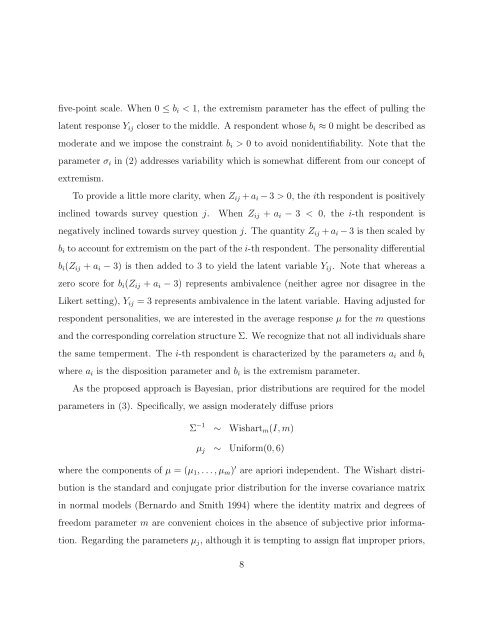Bayesian analysis of ordinal survey data using the Dirichlet process ...
Bayesian analysis of ordinal survey data using the Dirichlet process ...
Bayesian analysis of ordinal survey data using the Dirichlet process ...
You also want an ePaper? Increase the reach of your titles
YUMPU automatically turns print PDFs into web optimized ePapers that Google loves.
five-point scale. When 0 ≤ b i < 1, <strong>the</strong> extremism parameter has <strong>the</strong> effect <strong>of</strong> pulling <strong>the</strong>latent response Y ij closer to <strong>the</strong> middle. A respondent whose b i ≈ 0 might be described asmoderate and we impose <strong>the</strong> constraint b i > 0 to avoid nonidentifiability. Note that <strong>the</strong>parameter σ i in (2) addresses variability which is somewhat different from our concept <strong>of</strong>extremism.To provide a little more clarity, when Z ij + a i − 3 > 0, <strong>the</strong> ith respondent is positivelyinclined towards <strong>survey</strong> question j. When Z ij + a i − 3 < 0, <strong>the</strong> i-th respondent isnegatively inclined towards <strong>survey</strong> question j. The quantity Z ij + a i − 3 is <strong>the</strong>n scaled byb i to account for extremism on <strong>the</strong> part <strong>of</strong> <strong>the</strong> i-th respondent. The personality differentialb i (Z ij + a i − 3) is <strong>the</strong>n added to 3 to yield <strong>the</strong> latent variable Y ij . Note that whereas azero score for b i (Z ij + a i − 3) represents ambivalence (nei<strong>the</strong>r agree nor disagree in <strong>the</strong>Likert setting), Y ij = 3 represents ambivalence in <strong>the</strong> latent variable. Having adjusted forrespondent personalities, we are interested in <strong>the</strong> average response µ for <strong>the</strong> m questionsand <strong>the</strong> corresponding correlation structure Σ. We recognize that not all individuals share<strong>the</strong> same temperment. The i-th respondent is characterized by <strong>the</strong> parameters a i and b iwhere a i is <strong>the</strong> disposition parameter and b i is <strong>the</strong> extremism parameter.As <strong>the</strong> proposed approach is <strong>Bayesian</strong>, prior distributions are required for <strong>the</strong> modelparameters in (3). Specifically, we assign moderately diffuse priorsΣ −1 ∼ Wishart m (I, m)µ j ∼ Uniform(0, 6)where <strong>the</strong> components <strong>of</strong> µ = (µ 1 , . . . , µ m ) ′ are apriori independent. The Wishart distributionis <strong>the</strong> standard and conjugate prior distribution for <strong>the</strong> inverse covariance matrixin normal models (Bernardo and Smith 1994) where <strong>the</strong> identity matrix and degrees <strong>of</strong>freedom parameter m are convenient choices in <strong>the</strong> absence <strong>of</strong> subjective prior information.Regarding <strong>the</strong> parameters µ j , although it is tempting to assign flat improper priors,8
















